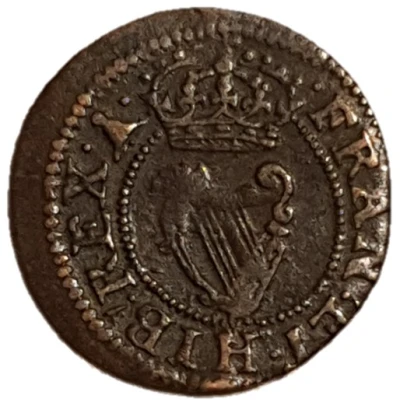


© Cameron Maclean (CC BY-NC-SA)
1 Farthing - Charles I Maltravers issue; types 1-3 ND
| Copper | 0.5 g | 16 mm |
| Issuer | England (United Kingdom, British Overseas Territories and Crown Dependencies) |
|---|---|
| King | Charles I (1625-1649) |
| Type | Token |
| Years | 1634-1636 |
| Value | 1 Farthing (1⁄960) |
| Currency | Pound sterling (1158-1970) |
| Composition | Copper |
| Weight | 0.5 g |
| Diameter | 16 mm |
| Shape | Round |
| Technique | Roller milled |
| Orientation | Variable alignment ↺ |
| Demonetized | Yes |
| Updated | 2024-10-09 |
| Numista | N#48578 |
|---|---|
| Rarity index | 81% |
Reverse
Crowned harp within inner beaded circle, legend around
Script: Latin
Lettering: FRAN! ET. HIB! REX.
Unabridged legend: Franciae Et Hiberniae Rex
Translation: France and Ireland
Comment
Production contracted to Lord Maltravers; round type (oval type issued for use in Ireland).Privy mark varieties:
Type 1 double rose; woolpack
Type 2 double rose; woolpack; bell; large lis; small lis; martlet
Type 3 martlet/bell; woolpack/portcullis; lis/portcullis; harp/bell; harp/billet. Woolpack/double rose may be counterfeit.
Most Maltravers farthings have die orientation 12h but some Type 2 can also be 6h (privy marks double rose and woolpack only).
Weights can vary significantly - die orientation (especially if not 12h or 6h), privy marks and punctuation are much better indicators of authenticity. Genuine issues are also well-centred.
Interesting fact
One interesting fact about the Token 1 Farthing - Charles I (Maltravers issue; types 1-3) ND (1634-1636) from England (United Kingdom, British Overseas Territories and Crown Dependencies) made of Copper weighing 0.5 g is that it was issued during a time of great economic turmoil in England. The coin was minted during the reign of Charles I, who faced significant financial challenges due to the cost of military campaigns and the decline of the English economy. As a result, the coin was made with a relatively low denomination and was intended to be used for everyday transactions. Despite its low value, the coin is now highly sought after by collectors due to its historical significance and rarity.



